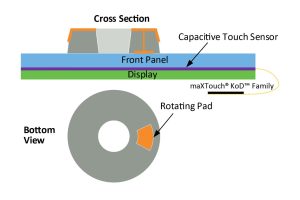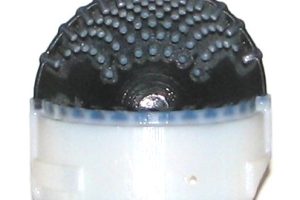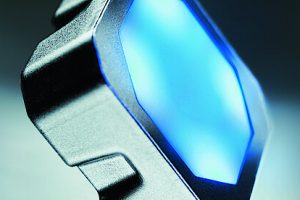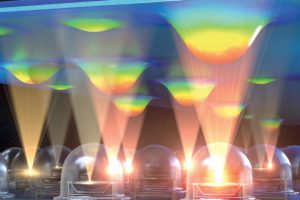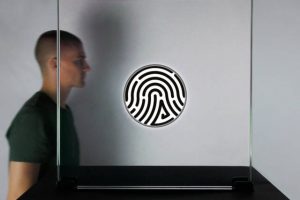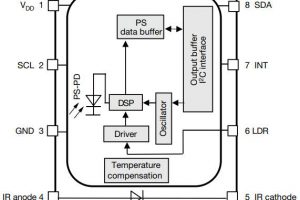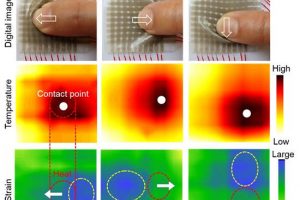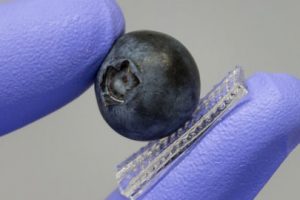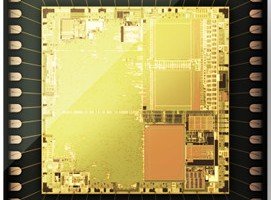Microchip has introduced a touch controller family for ‘knob-on-display’ (KoD) human-machine interfaces. These interfaces add a physical ‘clicky’ knob to the front of a display without traditional rotary encoder electronics. Instead, a passive rotatable clicky knob is simply stuck to the front of the display glass (diagram right) and one or more electrodes underneath interact with the display’s existing capacitive ...
Tag Archives: touch
Robotic finger tip makes human-like ‘nerve’ signals
Researches at the University of Bristol have created an artificial fingertip that produces signals that appear to mimic human touch nerve signal. “We found our 3D-printed tactile fingertip can produce artificial nerve signals that look like recordings from real, tactile neurons,” according to Bristol’s professor of robotics Nathan Lepora. “Human tactile nerves transmit signals from various mechanoreceptors, which can signal ...
Capacitive switch glues to rear of insulating panel
Schurter is aiming at easy-clean and sleek-looking surfaces with a ‘capacitive hidden switch’ that can be mounted behind thin non-conductive panel. Called the ‘CHS’ range, they come in three versions: non-illuminated, illuminated and sealed illuminated. They are mounted by gluing them to the back of the panel with pre-installed 3M 468MP tape. CHS 1 circuit – output is an open collector ...
Haptic touch display activated by LEDs
LEDs could be used to deform and vibrate a haptic touch display, according to researchers at Korea’s Electronics and Telecommunications Research Institute (ETRI). Demonstrating the mechanism, the team made a 3 x 3 matrix with nine 10 x 10mm vibrating units (touchels perhaps?). It involves a plastic bi-morph layer – the two-dimensional polymer equivalent of a bi-metallic strip – in this case, ...
UK made: Transparent power delivery for glass
Zytronic of Newcastle has introduced a way of delivering power through glass invisibly, calling it Electroglaz. “Electroglaz is completely transparent and can be used to ‘magically’ power a near limitless variety of low power, electronic and electrotechnical devices embedded within a glass panel,” said company marketing director Ian Crosby. “Potential applications include LED lit display cases and shelving units for museums, ...
I2C infra-red proximity sensor measures to 20µm movement or at 500mm range
Vishay has release of two high-resolution automotive grade optical reflective proximity sensors that operate down to 20µm for force sensing applications. In use, an infra-red beam is sent out and its reflection detected. Sensing can be from up-close to half a meter away, and can have enough resolution to detect the displacement of a surface for force, push or glove-independent ...
E-skin detects both temperature and force with one sensor
Ion-based sensing is at the heart of an e-skin that can separately detect temperature and pressure through a single mechanism. To create the skin, Pohang University of Science and Technology (Postech) teamed up with Stanford University. “Human skin is freely stretchable yet unbreakable because it is full of electrolytes, so the joint research team made the sensor using them,” according ...
e-skin senses sideways force as well as direct force
An electronic copy of human skin can detect force, and the direction of that force. When griping with thumb and fingers, a robot hand using this could sense both the weight of an object and the force applied to it, allowing more sophisticated manipulation. “This technology puts us on a path to one day giving robots the sort of sensing capabilities ...
Modules combine Microchip touch and 3D gesture sensing
Microchip has revealed a pair of linked peripheral modules that can combined projected multi-touch 2D and 3D gesture sensing for microcontrollers. Developed with Silicon Integrated Systems (SiS), both are capacitive, with the 3D sensing based on strip electrodes along each edge of the display. A version of its GestIC technology, it can track a hand up to 200mm from the ...
Atmel adds force sensing to capacitive touch
Atmel has found a way to add a force dimension to its touch screen chips without straying from capacitive measurement. The technology is sampling in its maXTouch U chip series for phones. “Force sensing expands the touch experience by bringing 3D interactions to enable users more intuitive control of their devices based on the pressure of their touch,” said the ...
 Electronics Weekly Electronics Design & Components Tech News
Electronics Weekly Electronics Design & Components Tech News
